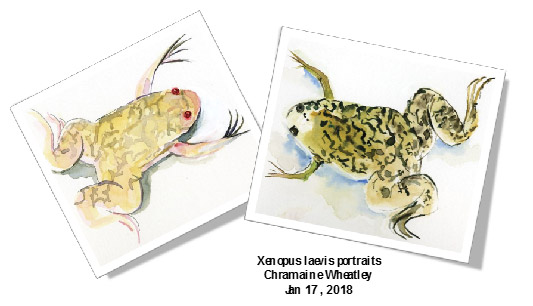Xenopus laevis Research Resource for Immunobiology
Ever since it was discovered that X. laevis could easily be induced to breed in the laboratory by injecting human gonadotrophin, this anuran amphibian has become the model of choice for research in all sorts of biological fields ranging from early developmental biology and metamorphosis to behavior and immunity. In particular, evolutionary distance of X. laevis from mammals permits distinguishing species-specific adaptation from more conserved features of the immune system.
The University of Rochester is home to the world's most comprehensive resource specializing in the use of the amphibian Xenopus laevis for biomedical and immunological research. Several genetically-defined inbred strains and clones are available for study. The facility also maintains and develops research tools such as transgenic animals, monoclonal antibodies, cell lines, DNA libraries and molecular probes. The resource includes a satellite facility devoted to study infectious diseases caused by iridovirus. Technical assistance, education and training are also provided. The resource is supported by the National Institute of Allergy and Infectious Diseases (NIH/NIAID).
Xenopus: A Great Animal Model for Immunological Research
As a representative jawed vertebrate, the amphibian Xenopus is in a phylogenetically intermediate position between aquatic vertebrates and land tetrapods. Notably, Xenopus exhibits an immune system fundamentally similar to that of mammals including leukocytes involved in innate immunity as well as B and T lymphocytes expressing a wide repertoire of somatically generated receptors. Because its immune system remarkably conserved and similar to that of mammals, Xenopus serve as a useful animal model, alternative to mouse for fundamental and medical immunological research related to infectious, developmental and autoimmune diseases as well as cancer.

More specifically, the Xenopus immune system is characterized by a thymus and a spleen; T and B cells with Rag-mediated rearranging T-cell receptors (TCR) and immunoglobulin (Ig) receptors, respectively; AID-mediated hypermutations and Ig isotype heterogeneity; key cytokines and MHC class I and class II genes. MHC-restricted cytotoxic and helper T cell responses have been identified (reviewed in [1-3]), as well as a prominence of innate-like (i)T cells [4-7] of growing medical interest. The Xenopus model includes fully sequenced and annotated genomes of two species, X. tropicalis [8] and X. laevis [9], as well as large gene expression databases (all accessible through Xenbase - http://www.xenbase.org/common/). Tools indispensable for immunological studies are available in Xenopus including monoclonal antibodies (mAbs) specific for X. laevis NK, B, and T cells and important immune-related molecules such as CD8, MHC, etc. [1]. Crucial for immunological studies, MHC-defined inbred strains and cloned animals are also available. Finally, the development and utilization of novel technologies for loss-of-function and genome editing combined with transgenesis as well as availability of transgenic lines with various cell types expressing fluorescence reporters further empower Xenopus as a research platform for immunological research.
- Robert, J. and Y. Ohta, Comparative and developmental study of the immune system in Xenopus. Dev Dyn, 2009. 238(6): p. 1249-70.
- Robert, J. and N. Cohen, The genus Xenopus as a multispecies model for evolutionary and comparative immunobiology of the 21st century. Dev Comp Immunol, 2011. 35(9): p. 916-23.
- Du Pasquier, L., J. Schwager, and M.F. Flajnik, The immune system of Xenopus. Annu Rev Immunol, 1989. 7: p. 251-75.
- Edholm, E.S., et al., Nonclassical MHC class I-dependent invariant T cells are evolutionarily conserved and prominent from early development in amphibians. Proc Natl Acad Sci U S A, 2013. 110(35): p. 14342-7.
- Edholm, E.S., et al., Nonclassical MHC-Restricted Invariant Valpha6 T Cells Are Critical for Efficient Early Innate Antiviral Immunity in the Amphibian Xenopus laevis. J Immunol, 2015. 195(2): p. 576-86.
- Edholm, E.S., et al., Unusual evolutionary conservation and further species-specific adaptations of a large family of nonclassical MHC class Ib genes across different degrees of genome ploidy in the amphibian subfamily Xenopodinae. Immunogenetics, 2014. 66(6): p. 411-26.
- Robert, J. and E.S. Edholm, A prominent role for invariant T cells in the amphibian Xenopus laevis tadpoles. Immunogenetics, 2014.
- Hellsten, U., et al., The genome of the Western clawed frog Xenopus tropicalis. Science, 2010. 328(5978): p. 633-6.
- Session, A.M., et al., Genome evolution in the allotetraploid frog Xenopus laevis. Nature, 2016. 538(7625): p. 336-343.